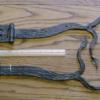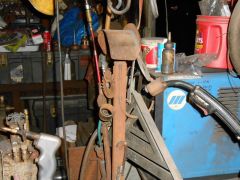-
Posts
685 -
Joined
-
Last visited
Content Type
Profiles
Forums
Articles
Gallery
Downloads
Events
Everything posted by metalmangeler
-

winterizing air hammers?
metalmangeler replied to ckent's topic in Power Hammers, Treadle Hammers, Olivers
I use a uttility style hammer in an unheated shop here in south central Alaska. When it is cold, below 0 F I start the day with an electric heater to warm up the compressor. I try to end the day with enough hand work left to keep me busy for an hour or so while the shop warms from the forge. sometimes I stock this type of work for cold times. I have had the oilers go out several times always in the winter, I think the diaphram does not like the cold. I try to do my taxes during really cold days as they get done indoors. -

Could some experienced smiths give me some advice?
metalmangeler replied to IRO-bot's topic in Knife Making
If the bevel is all to one side in a blade maybe you have the blade lieing flat on the anvil rather than 1/2 the angle of your hammer face. In forgeing the near side, or cutting edge toward you you need your hammer hand to be lower in relation to the anvil than it would be to forge with the edge away. Forging both sides should give better results as the stresses of forging would be more uniform through out the blade. -
My elbow stopped bothering me after I got a power hammer. You may use this to help convince your wife of this NEED. :)
-
Looks really good.
-

Anyones Craft fair season started yet?
metalmangeler replied to KYBOY's topic in Blacksmithing, General Discussion
Today was the art sale Gala at a show we do here. We sold our peices but I think it was God's grace as there were many that I thought were really nice peices that did not sell. There is a show conected to this one that will go over the weekend we will be selling smaller stuff at, it will be interesting. Hopefully it will work as I have specialty stuff that I only sell there as it normally does not do so well at other venues. -
I also make my tongs from hardenable matterial, but I know of at least 2 comercial makers of farrier tongs that had to change to heavy and mild, because they could not teach thier customers not to quench tongs hot. If used correctly they will hold up fine if used incorrectly you will know about it.
-
They do look very nice, just in the wrong shop.
-
Hi Brian, I agree partly but also I think that one of his main points is that by changing the angle of the hammer you change the way it forges also by using half faced blows that is a different type of die. If you think about a power hammer and how it works say with flat dies, you have 2 dies matching (I hope) that come together meeting in one plane. Now if you want a smooth taper you change dies to get that or use hand held tooling (different dies) if you want half face blows you use different dies or move one of the dies to acheve this, if you want to hit at an angle you change dies or use a set tool to make an angle (different dies). much of this is done without really thinking about it with a hand hammer, but it is like using different dies and then when we change hammers or use the other hammer face or pein we increase our assortment of dies. The majority of shops that I have been in with a power hammer have a sever shortage of dies. The nice thing about hand hammering is that you have much more freedom in forging, with angles and a normal anvil provides many bottom dies as well, but it takes some understanding.
-
Hi Eric normally all the edges have the same radious but some hammers have larger radiouses than others. I just took the pictures so will try posting them. I agree that the main advantage of the square face is in drawing, as a cross pein or straight pein by tilting the hammer. This first one will be a round face ground square with large radiouses thus reduced hammer marks. this one is a forged square face with small radiouses the trapazoid is from the camra angle not the hammer. This one is a square forged hammer with the corners eased and a large radious. Hopefully that explains what I was trying to say.
-
Sorry I kind of got off topic there, I hope that you do well at the show.
-
Hi Tristan I did not mean to imply that you did not know the purpose of different hammer faces. Maybe I was speeking more to myself in that I will often be using my favored hammer and neglect that one specific to a function. Eric I to have used square flat side rounding hammer faces more than any others over the years. Mine differed from Brians in that the sides of mine were forged square and the edges had a smaller radious. I have done most of the clip evolution, starting with a round clip horn, then bob punch, then cross pein, then straight pein, then ball pein, thne a specific cliping hammer like a ball pein only the flat face had a straight radious on the heel to control the clip. For me I think I like the bob punch best and am doing that mostly now as it gives me the most control, I think the hammer clips are popular because they are a little quicker, but I can do 2 clips with a bob punch in one heat so that seems to be plenty to me. I have this year started to use this grind on my flat face. I really like it. I like the round tight radious for freeing pritchels and punches and the square edges for controled drawing.
-
That turned out nice.
-
I am glad that it is working out for you.:) Farriers and former farriers seem to use rounding hammers for everything, but there is a reason that they make cross pein and other style hammers.
-
Hey Dave I wish my first ones were that nice. I will make a suggestion, when looking at a half penny scroll look at the negative space. In my oppinion you made the scroll a little tight in that your neg. space stays the same for a while instead of growing from the start on out. Keep up the great work.
-
That depends on where you are, here it would be a pretty good deal. Most parts of the US it would only be a price. From what I see on this forum I would think in the UK it would be way over priced. If it were my anvil I would just use it and soon the top would be nice and shiny and the sides would still be rusty. If you wire brush it wear a respriator.
-
Very impressive.
-
Maybe you could use the potential cutomers arm if you run out of hair.
-
I guess it is a good thing you saved that leg from your strong right hand. :)
-

Aggression: Zombie Outbreak Response Blade
metalmangeler replied to Stormcrow's topic in Knife Making
I am just trying to imagine how good it would have cut had you used your strong right hand. ;) -

forge welding struck tool ends risk
metalmangeler replied to evfreek's topic in Tools, general discussion
Thanks fo the heads up. -

I make horse shoes,,,,, kinda
metalmangeler replied to SReynolds's topic in Blacksmithing, General Discussion
That makes lots of sense, if he put in a deep groove he would not need to use a forepunch, the groove would accept the nail heads and then the pritchel for the shank. This would be a different system than the original post though, as I think that was a plain stamped shoe. Mark -

I make horse shoes,,,,, kinda
metalmangeler replied to SReynolds's topic in Blacksmithing, General Discussion
Travis it is possible that he was using concave stock rather than flat bar to make the shoes from, most would still prefer to use a stem punch, but you could just use a pritchel and get the job done. If you just use a pritchel on flat bar the nail head would not fit or the hole would be much to large for the nail shank. I used to swedge round stock to concave for making some of my shoes from and I just pricheled them, but that was not what the original post was talking about. -

